Out of pocket, out of patience Rampant retail theft is impacting the bottom line, staff morale and customers’ limited resources already strained by high inflation
Read this article for free:
or
Already have an account? Log in here »
To continue reading, please subscribe:
Monthly Digital Subscription
$0 for the first 4 weeks*
- Enjoy unlimited reading on winnipegfreepress.com
- Read the E-Edition, our digital replica newspaper
- Access News Break, our award-winning app
- Play interactive puzzles
*No charge for 4 weeks then price increases to the regular rate of $19.00 plus GST every four weeks. Offer available to new and qualified returning subscribers only. Cancel any time.
Monthly Digital Subscription
$4.75/week*
- Enjoy unlimited reading on winnipegfreepress.com
- Read the E-Edition, our digital replica newspaper
- Access News Break, our award-winning app
- Play interactive puzzles
*Billed as $19 plus GST every four weeks. Cancel any time.
To continue reading, please subscribe:
Add Free Press access to your Brandon Sun subscription for only an additional
$1 for the first 4 weeks*
*Your next subscription payment will increase by $1.00 and you will be charged $16.99 plus GST for four weeks. After four weeks, your payment will increase to $23.99 plus GST every four weeks.
Read unlimited articles for free today:
or
Already have an account? Log in here »
Hey there, time traveller!
This article was published 31/03/2023 (981 days ago), so information in it may no longer be current.
To reach the Easter chocolate aisle, shopper Kaylee Goerzen must pass through two rounds of sliding doors and then a security gate.
She might nod to the Walmart employee on her right as she walks in. If she does, the action will likely be caught on camera.
Then she’ll wheel her cart — unchained after she plugged a loonie in to unlock it — to the sweet holiday treats.
Nearby employees, distinguishable in their blue and yellow vests, stock shelves and tidy the store. Others monitor the self-checkout area.
“There are a lot of workers who are there,” Goerzen noted. “It’s kind of obvious why.”
“There are a lot of workers who are there. It’s kind of obvious why.”–Kaylee Goerzen
It’s no coincidence there is a visible presence of staff and that the store’s physical setup is designed to slow shoppers coming and going.
Theft and violent crime at retailers and public-facing shops have skyrocketed in recent years, industry experts say. It’s omnipresent, sweeping across North America.
It’s caused some companies to shutter, others to rethink how they serve their customers. It’s become the focus of task forces and, recently, a national conference in Canada. It costs the industry billions of dollars annually, experts say, but the true number is not known because theft is vastly underreported.
Meanwhile, inflation persists. The cost of groceries continues to rise — prices increased 10.6 per cent this February compared to last. For seven consecutive months, the inflation rate for groceries has hit double-digit increases.
Goerzen feels compassion for perpetrators — “maybe some people have been moved to extreme measures to get by” — others, however, aren’t so sympathetic.
Drop a pin on a Winnipeg map and chances are the location has been the scene of a crime.
“I don’t think it matters what area of the city you’re in anymore. Crime is everywhere,” Sonja Holodryga said.
She cuts a customer’s hair steps away from her salon’s boarded-up door. Someone broke into Waverley Hair Design and stole change at the end of February. Those responsible also broke into four Pembina Highway businesses the same night, Holodryga said.
RUTH BONNEVILLE / WINNIPEG FREE PRESS Sonja Holodryga, owner of Waverley Hair Design, stands next to her front door which was boarded up due to a recent break-in.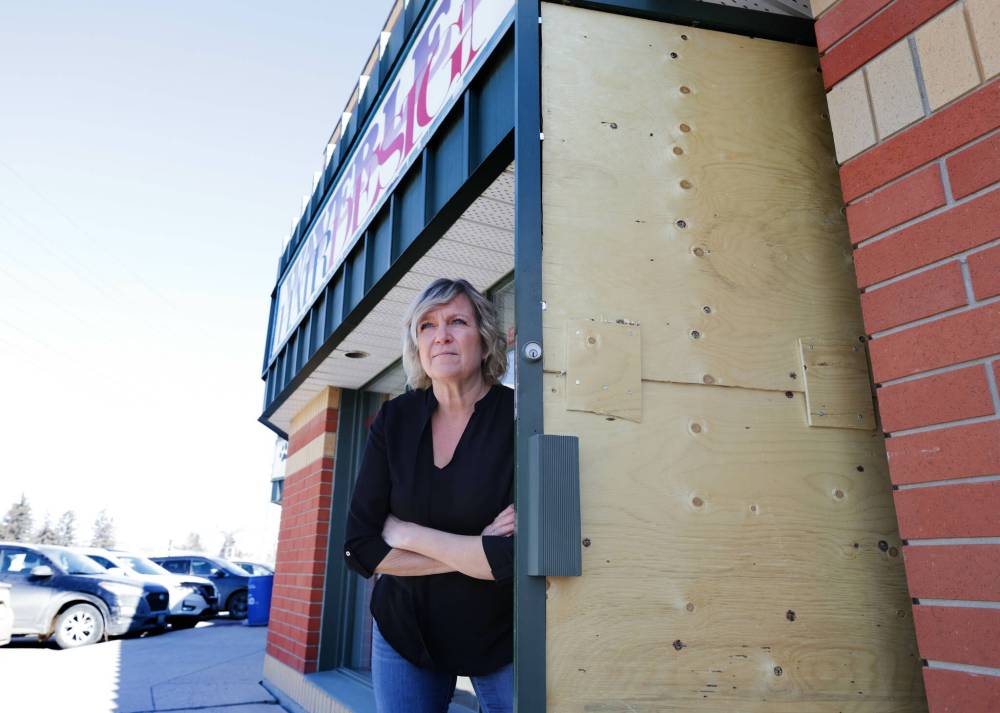
She repeats her story to each inquiring client: yes, it’s been a couple weeks since the incident, but she’s still waiting for repairs.
No, she’s not filing an insurance claim.
“The cost of my insurance would have been four times the amount by now if I claimed every time (over 18 years), so I just have to pay out of pocket,” she said.
It seems like authorities don’t care about break-ins if nobody’s been hurt, she added.
Chris Watchorn also hadn’t filed insurance claims after multiple break-ins at Hobby•ism this winter.
The menswear store, on the main floor of a Colony Street high-rise, opened on Boxing Day. That night, Hobby•ism was broken into twice.
“(The first person) wasn’t really deterred by the alarm system that was going off, or the people in the lobby, or the cars driving by,” Watchorn said.
MIKAELA MACKENZIE / WINNIPEG FREE PRESS Daniel Basanes (left) and Chris Watchorn are co-creators of Hobby•ism, a downtown menswear store that was robbed twice on its first day in business.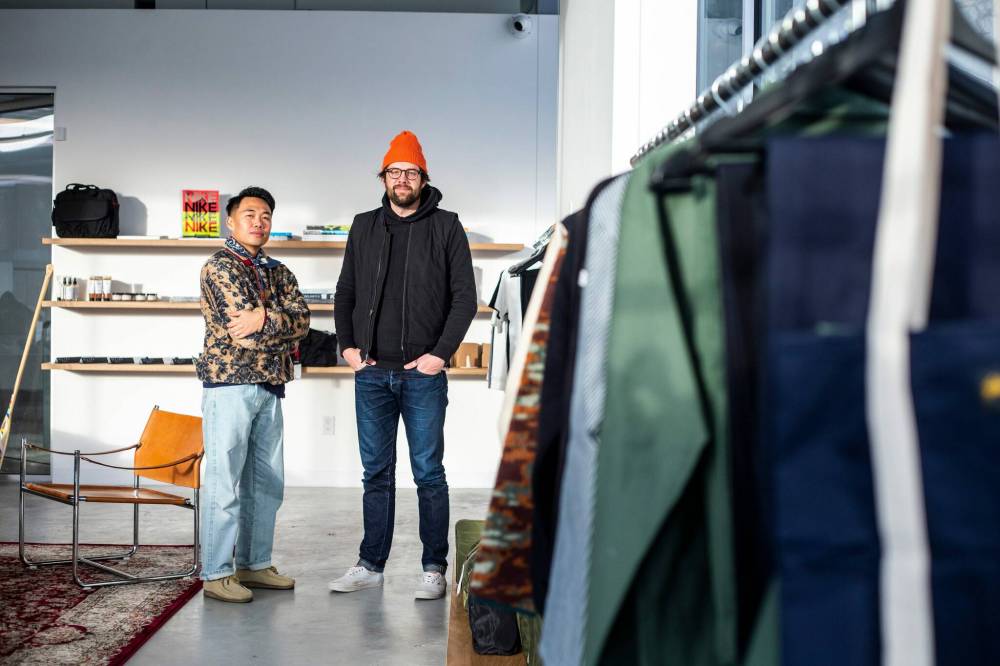
The man rode off on a bike with about $3,000 worth of hats, hoodies and bags. Hours later, after Watchorn met with police, a pair of thieves entered the store and took what they could.
“It’s just been a learning curve,” Watchorn said.
A third break-in occurred in January. Now, Hobby•ism has a $5,000 security gate, apparel isn’t left on shelves after hours and a broken window has been fixed.
“We’re still really excited to be downtown,” Watchorn said. “The response (from the community) has been overwhelming.”
Roughly two kilometres away, Eric Yaeger keeps coffee-bar items at Cookies by George close by.
“They steal this all the time,” Yaeger said, holding up a sugar canister and shaking it.
MIKAELA MACKENZIE / WINNIPEG FREE PRESS Eric Yaeger, who works at Cookies By George, says thieves regularly steal sugar from the coffee stand, and they’ve also broken in to steal soft drinks, among other things.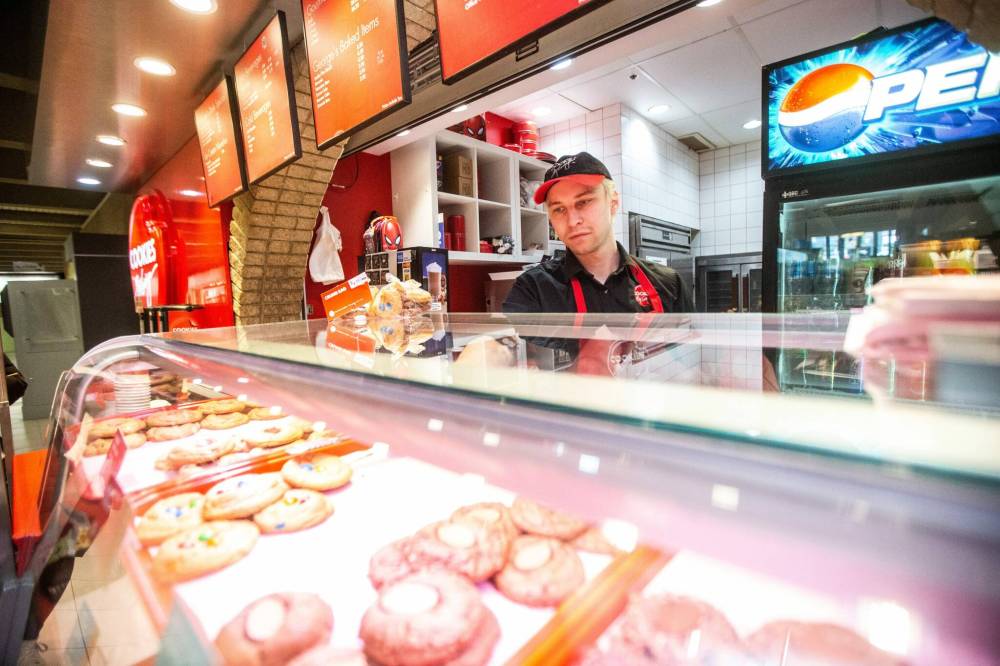
Lately, there have been break-ins after he closes his Winnipeg Square shop for the day. People search for soft drinks, energy drinks and, of course, sugar.
“People (are) always taking sugar to help with whenever they’re going off of the drug,” Yaeger said. “No one ever tries to steal money from me.”
Once, a security guard found someone chugging drinks behind the counter, Yaeger said. Another time, someone grabbed the coffee bar’s milk jug and threw it across the hall.
“So many (passersby) are desensitized,” Yaeger said. “You just go on about your life. This is greater than all of us.”
Many of the people trying to steal from Cookies by George are seemingly disadvantaged and in need of social services, Yaeger added.
“It’s really sad to see,” he said.
It’s impossible for the Retail Council of Canada to put an exact dollar amount on the extent of the problem since not all retailers report to the council and not all crimes are recorded. However, shoplifting has increased across all categories, including food and apparel, according to the organization’s spokeswoman.
“Escalating inflation, a growing re-sale market for stolen goods and increase of organized crime are some of the contributors,” Michelle Wasylyshen wrote in a statement.
Stephen O’Keefe, a Toronto-based retail consultant and president of Bottom Line Matters, believes retail theft is the worst it’s ever been, based on data in the United States. Canada usually follows its southern neighbour’s trends, he said.
The latest National Retail Security Survey in the U.S. found retail shrinkage — losses from theft, including by employees — was roughly US$94.5 billion in 2021, up from US$90.8 billion in 2020.
The figures don’t include costs to fix windows and repair other damages from break-ins.
“Escalating inflation, a growing re-sale market for stolen goods and increase of organized crime are some of the contributors.”–Michelle Wasylyshen
The shrinkage rate of 1.4 per cent was similar to the past five years. However, American retailers saw a 26.5 per cent increase in organized retail crime, such as theft rings. Eight in 10 retailers reported heightened violence and aggression.
Organized retail crime is a problem in Canada, too, O’Keefe said. People might sell stolen goods online or, in some cases, back to the retailer they took the items from at a discounted price in the industry’s “grey market.” The Free Press could not confirm this occurs in Manitoba.
Grocery stores’ profit margins typically hover between two and five per cent, pre-tax, O’Keefe said.
But crime is increasingly eating away at those margins, leaving smaller stores facing a difficult dilemma: increase prices to cover the loss, which means they can no longer compete with the box stores, or close for good.
Case in point: Dakota Family Foods.
Shoppers have repeatedly tried to exit the St. Vital-area store with full carts, duffel bags and reusable grocery totes without paying. Many times, they’ve been successful.
“We have issues hourly with shoplifting,” owner Scott Clement said.
Over the past year, there’s been a “substantial increase” in people walking out with unpaid goods.
MIKAELA MACKENZIE / WINNIPEG FREE PRESS Scott Clement, owner of Dakota Family Foods, said he’s seen a substantial increase in people just walking out with unpaid goods in the past year.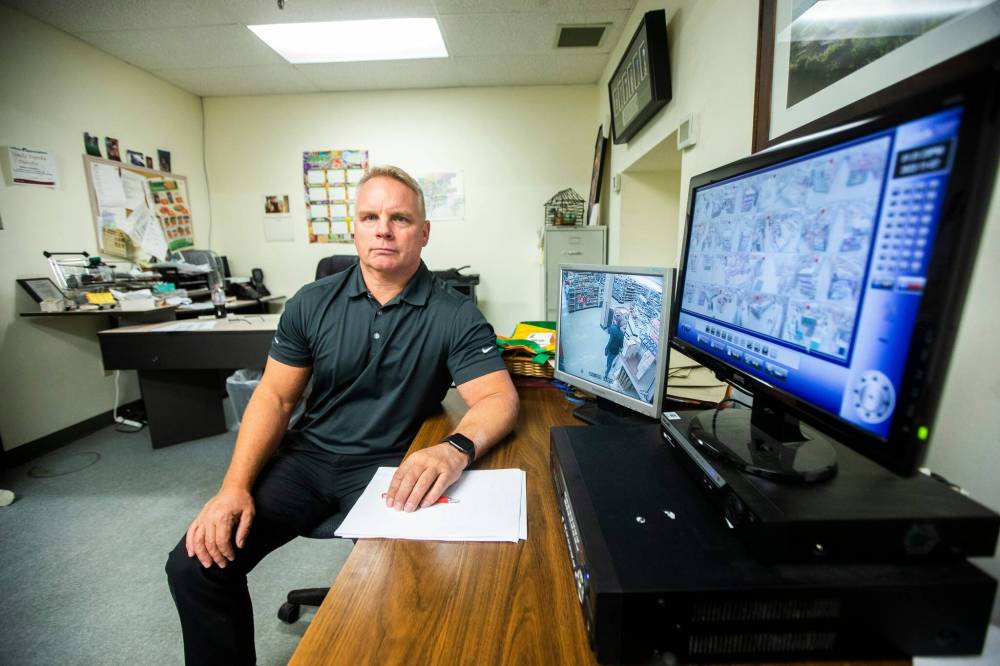
Meat, cheese and smaller, higher-priced items are popular to pocket, Clement said. Anywhere from $1,000 to $5,000 in goods are stolen weekly, he added.
“Unfortunately, we do have to pass on the costs to the customers when people shoplift,” Clement said.
Larger grocers are more likely to just swallow the losses, O’Keefe said.
“Because retailers are so competitive, they can’t layer on extra costs to offset theft,” O’Keefe said. “They have to compete on price.”
However, corporations are also feeling the impact of theft, O’Keefe said. He highlighted Walmart’s decision to pull its last stores from Portland, Ore. The corporation hasn’t confirmed crime as its reason for leaving, although other retailers who have left the city have said as much.
“Retail crime — including theft and arson — is sadly higher than it historically has been at Walmart Canada and across the retail industry,” Stephanie Fusco, Walmart Canada’s senior manager of corporate affairs, wrote in a statement.
The company is investing more in security and is part of the Retail Council of Canada’s loss-prevention advisory committee, Fusco added.
The numbers may appear to be trending in the right direction on paper, but they aren’t telling the real story.
According to the Winnipeg Police Service’s crime stats, there were roughly 3,000 fewer reported incidents of shoplifting under $5,000 in 2022 than in 2019, which recorded the five-year high.
There were 4,034 reports between January and November 2022 (the last available date for which statistics were available), compared to 7,425 during the same period in 2019.
“It may look, on the surface, like crime has gone down, but losses related to crime have gone up,” O’Keefe said, adding much of the crime goes unreported.

That’s what Winnipeg police suspect, as well.
“A lot of times, I think, (businesses) may record something internally, and they may not notify the police,” WPS Insp. Shawn Pike said. “We can only deal with what we’re getting reported.”
One south Winnipeg Walmart employee, who was tidying the shoe section on a recent morning, suggests that’s the case, saying it’s not uncommon to open a shoe box and find a soiled pair of sneakers instead of the new items inside.
The employee, who asked not to be identified, was alarmed by the thefts at first. Now she turns a blind eye.
“We cannot touch them,” she said. “We don’t care.”
“It seems like apathy has spread, or the disillusionment has spread, because there’s nothing being done.”–Jeff Traeger
Her feelings are shared across the province, according to Jeff Traeger, president of UFCW Local 832.
The union represents almost 20,000 Manitoba workers, including those at Superstore, Sobeys, Safeway and FreshCo.
Theft has increased “exponentially” alongside inflation rates, Traeger said.
One trend involves using a self-checkout but not scanning every item in the basket. On several occasions, armed people have hidden in backrooms waiting for the store to close before stealing, Traeger said.
Employees are often forbidden to intervene in shoplifting incidents. Security guards, outside of hired special-duty police, also have a hands-off policy.
“Grocery stores believe it’s a visual deterrent. If someone sees a security guard there, it might influence their behaviour.”–Jeff Traeger
“It seems like apathy has spread, or the disillusionment has spread, because there’s nothing being done,” Traeger said. “(Our members) are very frustrated with what they see.”
Some in the industry say arrests are happening, just not in front of workers’ eyes.
Meanwhile, the need for private security has grown. When Traeger began at the union 25 years ago, it represented between 300 and 400 security guards. The number has now ballooned to around 3,000, he said.
“Grocery stores believe it’s a visual deterrent,” he said. “If someone sees a security guard there, it might influence their behaviour.”
Guards take descriptive notes to aid police, he added.
Other retailers take additional steps and hire a special-duty Winnipeg police officer, which costs a minimum of $134 per hour. It may be more expensive, but officers can pursue thieves. Security guards are encouraged not to pursue offenders.
Read Hayes is an expert in retail theft. He’s a co-director of the Loss Prevention Research Council in the U.S., which also works with Canadian companies.
The reasons for increased crime are numerous. For one, there’s been an “erosion of consequences,” said Hayes, who is based in Florida.
“Most retailers don’t detain people for theft,” he said. “They don’t have the people there to do it, they don’t want their people to get injured or killed (and) there’s civil liability.”
His Canadian counterpart, O’Keefe, said “perceived lesser” crimes such as shoplifting are dropped to free up capacity in an already overburdened criminal justice system.
Pike couldn’t say how many Winnipeg shoplifters are caught and charged. However, punishment depends on the offender.
“If you have somebody that… has been caught before, over and over again for stealing — or if there’s violence involved in their offences — there’s more of a push to have the prosecution,” Pike said.
“Most retailers don’t detain people for theft. They don’t have the people there to do it, they don’t want their people to get injured or killed (and) there’s civil liability.”–Stephen O’Keefe
Others, such as first-time offenders, might receive “diversion methods,” such as apologizing to the shop or doing community service, Pike said.
According to the Criminal Code, the maximum sentence for theft under $5,000 is two years in jail, while the maximum for theft over $5,000 is 10 years in prison.
Once violence is involved, theft becomes robbery, and the offender could face a life sentence.
Businesses often report non-violent theft and robberies online. Police build case files on repeat offenders using the various reports, Pike said.
“They may be a suspect in another crime, and this (theft report) might be something that helps with that,” he said.
Violent crime has increased in and around several Winnipeg malls, according to police data. Between December 2021 and November 2022, Polo Park’s mall area saw 134 violent crimes, the most since at least 2018.
“They may be a suspect in another crime, and this (theft report) might be something that helps with that.”–WPS Insp. Shawn Pike
Police recorded 667 property crimes in the area for the same one-year time period, which is also a high compared to the past five years.
There were 44 violent crimes in the St. Vital Centre area reported to police between December 2021 and November 2022 — a 25 per cent leap from the previous year but close to 2019’s 39 reports.
Meantime, 56 violent crimes were reported in the Kildonan Place area between December 2021 and November 2022, an increase of 166 per cent from the previous year, and markedly higher than any of the previous five years.
Police recorded 230 property crimes in the area from January through November — a near 30 per cent increase from 2021, and also the highest in the past five years.
However, the shopping district near Kildonan Place, across Regent Avenue, accumulated far more shoplifting reports — 269 reports of shoplifting under $5,000 between December 2021 and November 2022, significantly higher than the 35 cases by Kildonan Place.
The shopping area includes Walmart, Superstore, Best Buy, Sephora and Sport Chek, among other retailers.
CF Polo Park and Kildonan Place declined interview requests. St. Vital Centre didn’t respond by deadline.
Winnipeg police prioritize calls involving active violent suspects. If physical harm is a possibility, officers are “striving to get there as fast as we can,” Pike said.
Situations where a thief has left, and no one has been injured, will not be as high a priority. The cases compete with every call in Winnipeg at the time, Pike said.
The Winnipeg Police Service is part of the province’s retail crime task force, which was formed in 2020 to address the mounting problem, along with businesses and industry lobbyists.
“It’s about preventing opportunities. It’s about, ‘What are systemic causes?’” Pike said. “There’s lots of conversation around that.”
The group considers socioeconomic factors, and the role of drug and alcohol addiction.
Hayes, from Florida, suggested there’s been a shift from greed-based to need-based crimes.
“It’s about preventing opportunities. It’s about, ‘What are systemic causes?’ There’s lots of conversation around that.”–Shawn Pike
“I used to use an example — ‘Well, nobody is stealing Spam. They’re stealing steaks and seafood and hair colour,’” Hayes said. “Now you’re seeing Spam being stolen.
“I don’t think they’re doing that out of greed, and I don’t think they’re doing that to show off.”
And that desperation is partly driven by wages not matching inflation, according to experts.
The typical Manitoban’s weekly earnings increased five per cent year over year last January. That same month, the province’s year-over-year inflation rate was 6.9 per cent. The gap was wider in prior months.
“I don’t agree with shoplifting,” Goerzen said, her Walmart cart filled with Easter goods. “But, I understand some people might be in that situation because grocery prices have gone up so much.”
Soo Park, a shopper at the same location, echoed Goerzen from a different aisle.
“I understand, due to the high costs, they may not have enough income to pay,” she said. “If I hear the parts of their story, I can understand it. Everyone has reasons.”
Several retailers and industry experts pointed to a need for more social programs to help those in need, saying it will likely decrease the crime statistics in the long-term.
In some ways, it’s like a game. As criminals get more creative, or more brazen, companies have to find ways to counter their moves. That could include locking up more items, such as razors, or affixing alarms to other products.
But one of their most effective crime-fighting tools is talking with each other.
Ravi Ramberran checks his group chat often. He and his neighbour business owners on McPhillips Street share descriptions of thieves. Photos from surveillance cameras are often circulated.
The collaboration began last fall, after Four Crowns Restaurant & Bar — which Ramberran owns — was broken into three times in a week. Nearby companies were also dealing with theft.
“Some businesses didn’t even have security cameras, which blew my mind,” Ramberran said.
MIKAELA MACKENZIE / WINNIPEG FREE PRESS Ravi Ramberran, owner of Four Crowns Restaurant & Bar, is part of a group chat with other McPhillips Street businesses to alert one another of shoplifters in the area or other security concerns.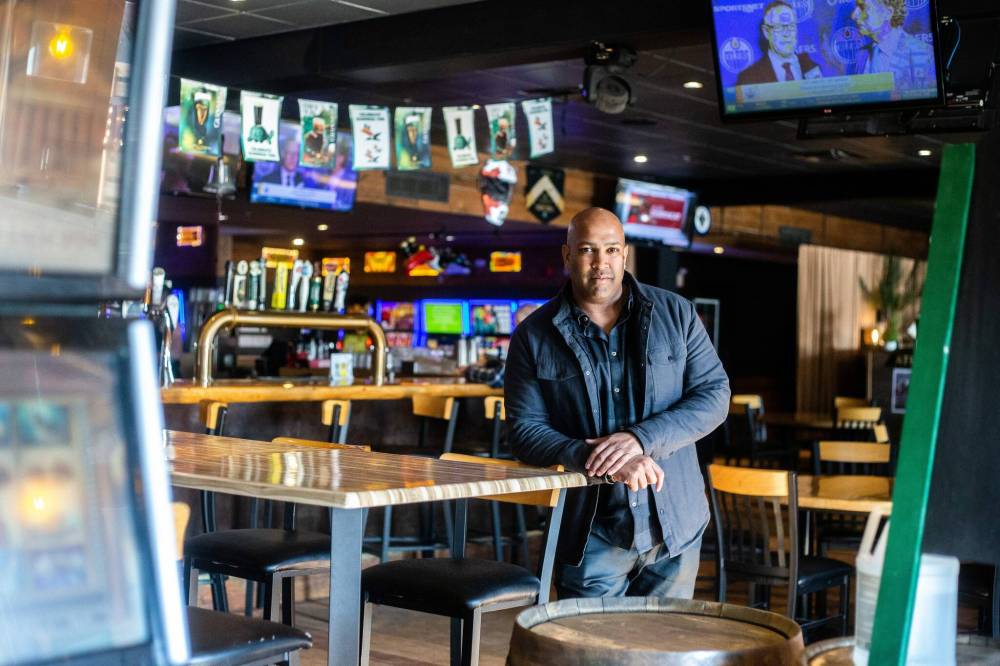
The companies formed an alliance and met with police to learn about crime-prevention strategies.
The group chat continues to be updated. Recently, a cannabis retailer on McPhillips was broken into. The shop shared a picture of the perpetrator.
“All of us now know what that person looks like, so we can keep our eyes open,” Ramberran said.
Should the suspect enter Four Crowns, staff might refuse service or ID the customer and “watch him like a hawk,” Ramberran added.
He and employees will detain thieves and call police if they think it’s safe to do so. Nobody’s gotten hurt yet, Ramberran said.
“I don’t think that society has done much to deal with this crime,” he said. “I think that the police are doing an amazing job, but I think that this problem is just so prevalent that no one can possibly keep up with it.”
Pike advises store staff and bystanders witnessing theft to take a hands-off approach and to contact police and provide as much information as possible.
“You think you’re stopping somebody for stealing one item, and then all of a sudden it turns into a fight,” he said. “Somebody gets hurt, or a weapon gets pulled.”
“I think that the police are doing an amazing job, but I think that this problem is just so prevalent that no one can possibly keep up with it.”–Ravi Ramberran
The type of collaboration employed by McPhillips Street businesses is occurring across the retail industry, O’Keefe said. He attended a national conference on loss prevention hosted by the Retail Council of Canada in March.
Topics included risk-management strategies and de-escalating violence in stores. Loss-prevention managers from corporations including Canadian Tire and Best Buy Canada spoke.
“The communication and collaboration… is getting so much better, I can’t see that (crime prevention) won’t improve,” O’Keefe said.
Meanwhile, more retailers are looking at technologically advanced solutions to combat theft. Hayes predicts artificial intelligence (AI) will recognize “high-impact offenders” in the future, allowing companies to take preventative measures before or as the person enters their store.
However, O’Keefe cautioned against AI decision-making.
“Twins exist,” he said. “You still have to have a person involved in the solution of AI to make the call.”
Meantime, business is brisk at Clearly InSight, a Winnipeg security firm. Owner Gary Williams said demand for systems is higher than it’s ever been during his 14 years in the industry, with sales more than doubling from 2021 to 2022.
“It’s continuing. Sales (are) definitely going to be higher,” he said. “People are scared… There isn’t a lot you can do when you’re broken into.”
Security cameras, commercial alarms and door access systems requiring key fobs are popular now.
“It’s something we have to consider every time we’re thinking about a technology… ‘How is this going to be perceived by the honest customer?’”–Gary Williams
AI security cameras are gaining steam in the province, Williams said, though he doesn’t offer cameras that track people’s faces.
Still, the number of AI camera uses are seemingly endless, he said.
He has a jewelry store client wanting a camera that tracks the number of customers filtering through the shop. The technology will also detect when items are missing and send an alert to the owner’s phone, Williams said.
“A vehicle comes in, there’s been a problem with that vehicle before — (the AI cameras) can immediately notify somebody that a vehicle is in that’s caused problems,” Williams said.
So far, he’s sold just a few AI cameras. An AI camera costs about double the price of a non-AI version and there’s often an annual or monthly fee for the corresponding app, Williams said.
Despite the increased crime and the heightened security measures, it’s important to remember most shoppers abide by the law, O’Keefe said.
“It’s something we have to consider every time we’re thinking about a technology… ‘How is this going to be perceived by the honest customer?’” he said. “We don’t want to offend them.”
gabrielle.piche@winnipegfreepress.com

Gabrielle Piché reports on business for the Free Press. She interned at the Free Press and worked for its sister outlet, Canstar Community News, before entering the business beat in 2021. Read more about Gabrielle.
Every piece of reporting Gabrielle produces is reviewed by an editing team before it is posted online or published in print — part of the Free Press‘s tradition, since 1872, of producing reliable independent journalism. Read more about Free Press’s history and mandate, and learn how our newsroom operates.
Our newsroom depends on a growing audience of readers to power our journalism. If you are not a paid reader, please consider becoming a subscriber.
Our newsroom depends on its audience of readers to power our journalism. Thank you for your support.













